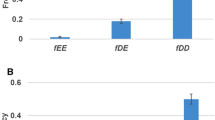Abstract
Neofunctionalization, subfunctionalization and increasing gene dosage were proposed to be the possible ways to explain duplicate-gene preservation in previous studies. However, in some natural populations, such as yeast Saccharomyces cerevisiae, a considerable proportion of the duplicate genes originated from ancient whole genomic duplication (WGD) is preserved till now, which cannot be sufficiently explained by these mechanisms. In this article, we present another possible way to explain this conundrum—originalization, by which duplicate genes are both preserved intact at a high frequency in the population under only purifying selection. With approximate equal rates of mutation at the two duplicated loci, analytical, numerical and simulation results consistently show that the mean time to nonfunctionalization for unlinked haploinsufficient gene duplication might become markedly prolonged, which results from originalization. These theoretical results imply that originalization might be an alternative effective and temporary way of preserving duplicate genes.




Similar content being viewed by others
References
Byrne KP, Wolfe KH (2005) The yeast gene order browser: combing curated homology and syntenic context reveals gene fate in polyploid species. Genome Res 15:1456–1461. doi:10.1101/gr.3672305
Clement Y, Tavares R, Marais GAB (2006) Does lack of recombination enhance asymmetric evolution among duplicate genes? Insight from the Drosophila melanogaster genome. Gene 385:89–95. doi:10.1016/j.gene.2006.05.032
Deutschbauer AM, Jaramillo DF, Proctor M et al (2005) Mechanisms of haploinsufficiency revealed by genome-wide profiling in yeast. Genetics 169:1915–1925. doi:10.1534/genetics.104.036871
Ferris SD, Whitt GS (1979) Evolution of the differential regulation of duplicate genes after polyploidization. J Mol Evol 12:267–317. doi:10.1007/BF01732026
Force A, Lynch M, Pickett FB et al (1999) Preservation of duplicate genes by complementary, degenerative mutation. Genetics 151:1531–1545
He X, Zhang J (2005) Rapid subfunctionalization accompanied by prolonged and substantial neofunctionalization in duplicate gene evolution. Genetics 169:1157–1164. doi:10.1534/genetics.104.037051
Hooper SD, Berg OG (2003) On the nature of gene innovation: duplication patterns in microbial genomes. Mol Biol Evol 20:945–954. doi:10.1093/molbev/msg101
Hughes MK, Hughes AL (1993) Evolution of duplicate genes in a tetraploid animal, Xenopus laevis. Mol Biol Evol 10:1360–1369
Khazanie RG, McKean HE (1966a) A Mendelian Markov process with binomial transition probabilities. Biometrika 53:37–48
Khazanie RG, McKean HE (1966b) A Mendelian Markov process with multinomial transition probabilities. J Appl Probab 3:353–364. doi:10.2307/3212124
Kimura M (1955a) Solution of a process of random genetic drift with a continuous model. Proc Natl Acad Sci USA 41:144–150. doi:10.1073/pnas.41.3.144
Kimura M (1955b) Stochastic processes and distribution of gene frequencies under the natural selection. Cold Spring Harb Symp Quant Biol 20:33–53
Kimura M, King JL (1979) Fixation of a deleterious allele at one of two “duplicate” loci by mutation pressure and random drift. Proc Natl Acad Sci USA 76:2858–2861. doi:10.1073/pnas.76.6.2858
Kincaid D, Cheney W (2002) Numerical analysis: mathematics of scientific computing, 3rd edn. Brooks/Cole Publication Co, Pacific Grove
Kondrashov FA, Koonin EV (2004) A common framework for understanding the origin of genetic dominance and evolutionary fates of gene duplicates. Trends Genet 20:287–291. doi:10.1016/j.tig.2004.05.001
Li W-H (1980) Rate of gene silencing at duplicate loci: a theoretical study and interpretation of data from tetraploid fishes. Genetics 95:237–258
Li W-H, Yang J, Gu X (2005) Expression divergence between duplicate genes. Trends Genet 21:602–607
Long M-Y, Betran M, Thornton K et al (2003) The origin of new genes: glimpses from the young and old. Nat Rev Genet 4:865–875. doi:10.1038/nrg1204
Lynch M, Conery JS (2004) The origins of genomic complexity. Science 302:1401–1404. doi:10.1126/science.1089370
Lynch M, Force A (2000) The probability of duplicate gene preservation by subfunctionalization. Genetics 154:459–473
Lynch M, Katju V (2004) The altered evolutionary trajectories of gene duplicates. Trends Genet 20(11):544–549. doi:10.1016/j.tig.2004.09.001
Moore RC, Purugganan MD (2003) The early stages of duplicate gene evolution. Proc Natl Acad Sci USA 100:15682–15687. doi:10.1073/pnas.2535513100
Ohno S (1970) Evolution by gene duplication. Springer-Verlag, New York
Papp B, Pail C, Hurst LD (2003) Dosage sensitivity and the evolution of gene families in yeast. Nature 424:194–197. doi:10.1038/nature01771
Rice SH (2004) Evolutionary theory: mathematical and conceptual foundations. Sinauer Associates Inc, Sunderland
Takahata N, Maruyama T (1979) Polymorphism and loss of duplicate gene expression: a theoretical study with application to the tetraploid fish. Proc Natl Acad Sci USA 76:4521–4525. doi:10.1073/pnas.76.9.4521
Walsh JB (2003) Population-genetic models of the fates of duplicate genes. Genetica 118:279–294. doi:10.1023/A:1024194802441
Wang Y, Rannala B (2004) A novel solution for the time-dependent probability of gene fixation or loss under natural selection. Genetics 168:1081–1084. doi:10.1534/genetics.104.027797
Watterson GA (1983) On the time for gene silencing at supplicate loci. Genetics 105:745–766
Wolfe KH, Shields DC (1997) Molecular evidence for an ancient duplication of the entire yeast genome. Nature 387:708–713. doi:10.1038/42711
Acknowledgments
This work is partly supported by funds from Yunan University and we acknowledge assistance from the Center for High Performance Computation of Yunnan University. We thank anonymous reviewers for many valuable comments and also thank Drs. Huatao Deng, Tianhong Xu, Shuqun Liu, Yang Shen, Xianda Lu, Ren Huang, Suhua Shi, Lianghu Qu, Yupeng Cun and Michael Lynch for their assistance and Sara Barton for editorial review. The junior author also graciously acknowledges his fellowships from GuangDong Institute for Monitoring Laboratory Animals and Tarim Agricultural University.
Author information
Authors and Affiliations
Corresponding author
Appendix
Appendix
Let x 0, x 1, x 2, x 3 be the frequencies of chromosomal haplotypes, “00”, “01”, “10” and “11”, respectively; and r be the recombination rate; mutation rates at duplicated loci are μ 1 and μ 2; for the DNR selective model, s 1 = 0; for the HI model, s 1 = 1. Fitness of individuals with various genotypes under the DNR and HI selective models are shown in Table 1. At every generation, mean population fitness and differential changes of chromosomal haplotype frequencies are given by
Because w ≈ 1, Eq. A2 can be approximately given by
Thus, Eq. 1 in the text is obtained.
Rights and permissions
About this article
Cite this article
Xue, C., Fu, Y. Preservation of duplicate genes by originalization. Genetica 136, 69–78 (2009). https://doi.org/10.1007/s10709-008-9311-5
Received:
Accepted:
Published:
Issue Date:
DOI: https://doi.org/10.1007/s10709-008-9311-5




